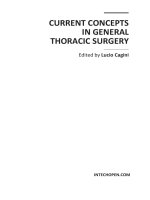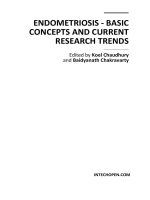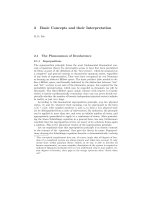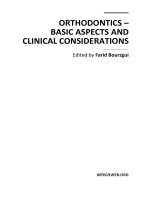Endometriosis - Basic Concepts and Current Research Trends Edited by Koel Chaudhury and Baidyanath Chakravarty ppt
Bạn đang xem bản rút gọn của tài liệu. Xem và tải ngay bản đầy đủ của tài liệu tại đây (20.38 MB, 500 trang )
ENDOMETRIOSIS - BASIC
CONCEPTS AND CURRENT
RESEARCH TRENDS
Edited by Koel Chaudhury
and Baidyanath Chakravarty
Endometriosis - Basic Concepts and Current Research Trends
Edited by Koel Chaudhury and Baidyanath Chakravarty
Published by InTech
Janeza Trdine 9, 51000 Rijeka, Croatia
Copyright © 2012 InTech
All chapters are Open Access distributed under the Creative Commons Attribution 3.0
license, which allows users to download, copy and build upon published articles even for
commercial purposes, as long as the author and publisher are properly credited, which
ensures maximum dissemination and a wider impact of our publications. After this work
has been published by InTech, authors have the right to republish it, in whole or part, in
any publication of which they are the author, and to make other personal use of the
work. Any republication, referencing or personal use of the work must explicitly identify
the original source.
As for readers, this license allows users to download, copy and build upon published
chapters even for commercial purposes, as long as the author and publisher are properly
credited, which ensures maximum dissemination and a wider impact of our publications.
Notice
Statements and opinions expressed in the chapters are these of the individual contributors
and not necessarily those of the editors or publisher. No responsibility is accepted for the
accuracy of information contained in the published chapters. The publisher assumes no
responsibility for any damage or injury to persons or property arising out of the use of any
materials, instructions, methods or ideas contained in the book.
Publishing Process Manager Bojan Rafaj
Technical Editor Teodora Smiljanic
Cover Designer InTech Design Team
First published May, 2012
Printed in Croatia
A free online edition of this book is available at www.intechopen.com
Additional hard copies can be obtained from
Endometriosis - Basic Concepts and Current Research Trends,
Edited by Koel Chaudhury and Baidyanath Chakravarty
p. cm.
ISBN 978-953-51-0524-4
Contents
Preface IX
Section 1 Endometriosis 1
Chapter 1 Endometriosis 3
Mohammad Reza Razzaghi,
Mohammad Mohsen Mazloomfard and Anahita Ansari Jafari
Chapter 2 Urinary Tract Endometriosis 31
Aliasghar Yarmohamadi and Nasser Mogharabian
Chapter 3 Diagnosis and Treatment of Perineal Endometriosis 53
Lan Zhu, Na Chen and Jinghe Lang
Chapter 4 Abdominopelvic Complications of Endometriosis 65
Arturo del Rey-Moreno
Chapter 5 Endometrial Tumors in Postoperative Scars - Pathogenesis,
Diagnostics and Treatment 85
Stanisław Horák and Anita Olejek
Chapter 6 Pathological Aspects of Endometriosis 101
Agatha Kondi-Pafitis
Section 2 Pathogenesis 113
Chapter 7 Involvement of Prostaglandins in
the Pathophysiology of Endometriosis 115
Gabriela F. Meresman and Carla N. Olivares
Chapter 8 Genetic Polymorphisms and
Molecular Pathogenesis of Endometriosis 133
Vijayalakshmi Kodati and Q. Hasan
VI Contents
Chapter 9 Progesterone Resistance and Targeting the Progesterone
Receptors: A Therapeutic Approach to Endometriosis 157
Nick Pullen
Chapter 10 Endometriosis and Angiogenic Factors 183
P. G. Artini, M. Ruggiero, F. Papini,
G. Simi, V. Cela and A. R. Genazzani
Chapter 11 The Local Immune Mechanisms Involved in
the Formation of Endometriotic Lesions 211
Yulia Antsiferova and Natalya Sotnikova
Chapter 12 Virus Infection and Type I Interferon in Endometriosis 245
Pia M. Martensen, Anna L. Vestergaard and Ulla B. Knudsen
Chapter 13 Stem Cell as the Novel Pathogenesis of Endometriosis 263
Eing-Mei Tsai
Chapter 14 Green Tea for Endometriosis 277
Gene Chi Wai Man, Hui Xu and Chi Chiu Wang
Chapter 15 Endometrial Stem Cells and Endometriosis 297
Jafar Ai and Esmaeil Sadroddiny
Section 3 Recent Research Trends 309
Chapter 16 Endometriosis-Associated Ovarian Cancer: The Role of
Oxidative Stress 311
Yoriko Yamashita and Shinya Toyokuni
Chapter 17 Alteration in Endometrial Remodeling: A Cause for
Implantation Failure in Endometriosis? 325
Saikat K. Jana, Priyanka Banerjee, Shyam Thangaraju,
Baidyanath Chakravarty and Koel Chaudhury
Chapter 18 Pathomechanism of Infertility in Endometriosis 343
Hendi Hendarto
Chapter 19 Analysis of Differential Genes of Uyghur Women with
Endometriosis in Xinjiang 355
Aixingzi Aili, Ding Yan, Hu Wenjing,
Yang Xinhua and Hanikezi Tuerxun
Chapter 20 Primary Afferent Nociceptors and Visceral Pain 367
Victor Chaban
Contents VII
Chapter 21 Embryo Quality and Pregnancy Outcome
in Infertile Patients with Endometriosis 383
Veljko Vlaisavljević, Marko Došen and Borut Kovačič
Chapter 22 Endometriosis and Infertility:
The Role of Oxidative Stress 399
Ionara Barcelos and Paula Navarro
Section 4 Diagnosis and Treatment 417
Chapter 23 Current Insights and Future Advances in
Endometriosis Diagnostics 419
Michele Cioffi and Maria Teresa Vietri
Chapter 24 Imaging Tools for Endometriosis: Role of Ultrasound,
MRI and Other Imaging Modalities in
Diagnosis and Planning Intervention 437
Shalini Jain Bagaria,
Darshana D. Rasalkar and Bhawan K. Paunipagar
Chapter 25 Pelvic Endometriosis: A MR Pictorial Review 447
Rosario Francesco Grasso, Riccardo Del Vescovo,
Roberto Luigi Cazzato and Bruno Beomonte Zobel
Chapter 26 Pathophysiological Changes in Early Endometriosis 459
Tao Zhang, Gene Chi Wai Man and Chi Chiu Wang
Chapter 27 Medical Treatment in Endometriosis 475
Elham Pourmatroud
Chapter 28 Sequential Management with
Gonadotropin-Releasing Hormone Agonist
and Dienogest of Endometriosis-Associated
Uterine Myoma and Adenomyosis 485
Atsushi Imai, Hiroshi Takagi,
Kazutoshi Matsunami and Satoshi Ichigo
Preface
Dedication
We dedicate this book to thousands of women all over the world suffering from
endometriosis
Endometriosis is a progressive debilitating disease affecting the physical, social and
psychological aspects of normal life quality in nearly 1 of 7 women of reproductive
age. Endometriosis is considered to be an enigmatic disease owing to the lack of
specific set of symptoms, poorly understood pathogenesis, complexity in diagnosis
and limited therapeutic options available for management of the disorder. The last
three decades we have witnessed a significant volume of research related to
endometriosis. We felt the need to bring together contributions of experts working on
pathophysiology, diagnosis and therapeutic aspects of endometriosis. We genuinely
hope that the readers will enjoy reading these informative articles contributed by
eminent clinicians and scientists. We, as editors, would sincerely feel rewarded if the
readers put to use the contents of the book to alleviate the pain and misery of women
suffering from endometriosis, a disease which still remains a challenge.
We sincerely appreciate the valuable contributions of all the authors who have put in
considerable effort to make the book a success. We are grateful to Dr. Ashalatha Ganesh
for providing her expert opinion and valuable suggestions. We are most thankful to
InTech publisher for providing us with an opportunity to edit a book of such great
clinical relevance. Finally, our sincere thanks to Bojan Rafaj, Publishing Process Manager
for the excellent support extended to us throughout the editing process.
Koel Chaudhury (Editor)
Associate Professor
School of Medical Science and Technology
Indian Institute of Technology, Kharagpur
India
Baidyanath Chakravarty (Co-editor)
Director Institute of Reproductive Medicine
Salt Lake, Kolkata
India
Section 1
Endometriosis
1
Endometriosis
Mohammad Reza Razzaghi
1
,
Mohammad Mohsen Mazloomfard
2
and Anahita Ansari Jafari
2
1
Chairman of Urology Department,
2
Medical Laser Application Research Center,
Urology Department of Shohada Tajrish Hospital,
Shahid Beheshti University (MC), Teheran,
Iran
1. Introduction
Endometriosis is classically defined as the growth of endometrial glands and stroma at
extra-uterine sites, most commonly implanted over visceral and peritoneal surfaces within
the female pelvis (1). Though endometriosis has been described for the first time in 1690 by
the German physician, Daniel Shroen, researchers remain still unsure as to the definitive
cause of this disease (2). The most widely accepted theory for the pathogenesis of
endometriosis (retrograde menstruation/transplantation), proposed in the 1927 by Sampson
(3). Although a great deal has been learned about endometriosis since Sampson’s land mark
studies, there is still a lot about it that is unclear and controversial. It remains an enigmatic
disorder in that the cause, the natural history, and the precise mechanisms of its
presentation are not known (4).
Endometriosis is most commonly found on the pelvic peritoneum but may also be found on
the ovaries, rectovaginal septum, ureter, and rarely in the bladder, pericardium, and pleura.
More rarely, colon, small intestine, appendix, umbilical scar and even sites not closely
contiguous to the pelvis (e.g., lung and brain tissue) may also be involved (5). It is a leading
cause of disability in women of reproductive age, responsible for dysmenorrhea, pelvic pain
and subfertility. The most common symptoms for women who have endometriosis are
pelvic pain and infertility; both adversely affecting the quality of life. The pregnancy rate in
women with endometriosis is about half of women with tubal factor infertility and is
negatively correlated with the severity of disease. The cause of reproductive failure may be
due to poor oocyte development, implantation or embryogenesis. In addition to infertility, a
strong cause–effect relationship between endometriosis and pelvic pain is commonly
observed (6, 7). Dysmenorrhoea is associated with cyclic recurrent microbleeding within
various entities of ectopic endometriotic implants and consequent inflammation.
Endometriosis-related adhesions and compression or infiltration of nerves in the
subperitoneal pelvic space by ectopic lesions also cause painful symptoms (8, 9).
In the last few years, there is a growing interest in endometriosis, because of the large
number of women it affects (about 3–10% of the female population in the reproductive age,
and up to 40–80% of women complaining of pelvic pain) and the significant morbidity
Endometriosis - Basic Concepts and Current Research Trends
4
associated with this disease, mainly with regard to the possible consequences on
reproductive function and on the risk of developing gynecologic tumors, such as ovarian
cancer (10-12). The prevalence in women without symptoms is 2-50%, depending on the
diagnostic criteria used and the populations studied (9). The incidence of endometriosis is
difficult to quantify, as women with the disease are often asymptomatic, and imaging
modalities have low sensitivities for diagnosis. The primary method of diagnosis is
laparoscopy, with or without biopsy for histologic diagnosis (13, 14). Using this standard,
investigators have reported the annual incidence of surgically diagnosed endometriosis to
be 1.6 cases per 1,000 women aged between 15 and 49 years. The incidence is 40-60% in
women with dysmenorrhoea and 20-30% in women with subfertility. The severity of
symptoms and the probability of diagnosis increase with age. The most common age of
diagnosis is reported as around 40, although this figure came from a study in a cohort of
women attending a family planning clinic (15).
The clinical picture of endometriosis is widely heterogeneous. A correct diagnostic work-up
of these patients can sometimes be very difficult, since there are a number of gynecological,
intestinal and systemic diseases mimicking endometriosis, as well as other conditions that
could be associated with or area consequence of this disorder. Therefore, multidisciplinary
care should been courage to ensure correct evaluation and improve the management of
these patients (16).
2. Prevalence
Although endometriosis was originally felt to be a disease only seen in women who had
undergone a minimum of 5 years of ovulatory menstrual cycles, it is now well-documented
that endometriosis can be seen as early as the premenarchal age group, in girls who have
initiated thelarche (63). Prevalence is estimated to be 6–10% in the general female population
and 35–50% of the patients experience pain and/or infertility. The prevalence in women
without symptoms is 2-50%, depending on the diagnostic criteria used and the populations
studied (9). The true incidence of endometriosis in adolescents is difficult to quantify and
estimates vary among different studies. The incidence of endometriosis is difficult to
quantify, as women with the disease are often asymptomatic, and imaging modalities have
low sensitivities for diagnosis. Using this standard, investigators have reported the annual
incidence of surgically diagnosed endometriosis to be 1.6 cases per 1,000 women aged
between 15 and 49 years (64). The incidence is 40-60% in women with dysmenorrhoea and
20-30% in women with subfertility. According to the Endometriosis Association, 66% of
adult women with endometriosis report the onset of pelvic symptoms before age 20, and
those who seek care for symptoms as a teen see on average 4 or more physicians before
receiving a diagnosis (15).
3. Classification
The primary method of diagnosis is visualization of endometriotic lesions by laparoscopy,
with or without histologic confirmation. Since the extent of endometriosis can vary
widely
between individuals, attempts have been made to develop a standardized classification to
objectively assess the extent of endometriosis. Sampson, Acosta et al., and many other
investigators developed staging systems that have all been criticized for multiple reasons,
Endometriosis
5
including their inability to predict clinical outcomes, especially pregnancy rates (PRs) in
infertile patients. In 1979, the American Fertility Society (AFS) (now the American Society
for Reproductive Medicine, or ASRM) first proposed a classification system. This was
extensively evaluated, modified in 1985, and is still used today. Despite these revisions the
currently used revised AFS system has serious limitations, including not effectively
predicting the outcome of treatment.
The endometriosis fertility index (EFI) is a simple, robust, and validated clinical tool that
predicts PRs for patients after surgical staging of endometriosis (see figure below). The EFI
score ranges from 0–10, with 0 representing the poorest prognosis and 10 the best prognosis.
Half of the points come from the historical factors and half from the surgical factors. Uterine
abnormality was not included in the score. The EFI is very useful in developing treatment
plans in infertile patients with endometriosis. The EFI is useful only for infertility patients
who have had surgical staging of their disease. It is not intended to predict any aspect of
endometriosis-associated pain. It is required that the male and female gametes are
sufficiently functional to enable attempts at non-IVF conception. One factor found to predict
pregnancy that is not included in the EFI is uterine abnormality. Sensitivity analysis showed
that even with substantial variation in the assignment of functional scores the EFI varies
very little (65).
Endometriosis - Basic Concepts and Current Research Trends
6
4. Anatomic sites
Endometriosis may develop anywhere within the pelvis and on other extrapelvic peritoneal
surfaces. Although the
condition is usually limited to the ovaries, uterosacral ligaments,
and Douglas’ pouch,
it has been reported in almost every organ of the body. Extra-pelvic
endometriosis refers to endometrial implants found elsewhere in the body, including the
skin, central nervous system, gastrointestinal tract, urinary tract, lungs, and heart.
Macroscopically, three forms of endometriosis are described: superficial peritoneal (or
ovarian) endometriosis, endometriotic cyst of the ovary or ovarian endometrioma, and deep
infiltrating endometriosis (DIE).(4)
The most commonly affected sites are the pelvic organs and peritoneum, although other
parts of the body such as the lungs are occasionally affected. The extent of the disease varies
from a few, small lesions on otherwise normal pelvic organs to large, ovarian endometriotic
cysts endometriomas).
There can be extensive fibrosis in structures such as the uterosacral ligaments and adhesion
formation causing marked distortion of pelvic anatomy. Disease severity is assessed by
simply describing the findings at surgery or quantitatively, using a classification system
such as the one developed by the American Society for Reproductive Medicine (ASRM)
(1997). There is no correlation between such systems and the type or severity of pain
symptoms (66).
Endometriosis typically appears as superficial "powder burn" or "gunshot" lesions on the
ovaries,serosal surfaces and peritoneum-black, dark-brown, or bluish-puckered lesions,
nodules or small cysts containing old haemorrhage surrounded by a variable extent of
fibrosis. Atypical or "subtle" lesions are also common, including red implants (petechial,
vesicular, polypoid, hemorrhagic, red flamelike) and serous or clear vesicles. Other
appearances include white plaques or scarring and yellow-brown peritoneal discoloration of
the peritoneum (66, 67).
Endometriomas usually contain thick fluid like tar; such cysts are often densely adherent to
the peritoneum of the ovarian fossa and the surrounding fibrosis may involve the tubes and
bowel. Deeply infiltrating endometriotic nodules extend more than 5mm beneath the
peritoneum and may involve the utero-sacral ligaments, vagina, bowel, bladder or ureters.
The depth of infiltration is related to the type and severity of symptoms (4).
5. Pathophysiology
5.1 Etiology
Despite extensive research, its pathogenesis still remains elusive and the disorder is
considered to be ‘enigmatic’. Endometriosis is a multi-factorial disease with multi-faceted
features. The theories that have withstood the test of time and remain in vogue include
retrograde menstruation, coelomic metaplasia, and endometrial stem cells. All the
theories on its pathogenesis must be taken complementary to one another and by no way
are mutually exclusive. The most widely accepted theory is the implantation of viable
endometrial tissue onto peritoneal visceral structures from retrograde menstrual flow into
the pelvic cavity (17). However, the origin is multifactorial, also having hormone,
immune, and genetic components. The relationship of endometriosis to estrogen is well-
Endometriosis
7
established. Two thirds of women with a diagnosis of endometriosis report having a
family member with endometriosis. A large percentage of women with endometriosis
have other co-morbidities such as fibromyalgia, chronic fatigue syndrome,
hypothyroidism, allergies, asthma, and auto-immune disorders. The associated risk
factors are directly related to low body mass index (BMI), and family history and are
inversely related to exercise (18).
5.2 Retrograde menstruation
The earliest and most widely accepted theory relates to retrograde menstruation through the
fallopian tubes with subsequent dissemination of endometrial tissue within the peritoneal
cavity. Sampson’s theory of endometrial implantation, offered in the 1927, proposes that
retrograde menstruation through the fallopian tubes was responsible for endometriotic
lesions. Three prerequisites are necessary for Sampson’s theory: (1) retrograde menstruation,
(2) viability of menstrual endometrial cells, and (3) implantation of endometrial cells onto
the peritoneal/ovarian surfaces (3). Since the introduction of his theory, retrograde
menstruation has been confirmed at laparoscopy, and it appears to occur in the vast
majority of women. Keettel and Stein in the 1950s demonstrated the viability of shed
menstrual endometrial cells by invitro culture of menstrual endometrium (19). The viability
of retrograde menstrual endometrium has been shown by Mungyer et al by culturing
endometrial glands and stroma collected from peritoneal lavage (20). In addition to these
invitro studies, Ridley and Edwards injected menstrual blood into the skin of women
scheduled for a laparotomy in the next 3 to 6 months. On excision of this tissue, several
women had endometriotic lesions at the injection site. Further circumstantial evidence
supporting Sampson’s theory is the increased risk of endometriosis in women with
Mullerian anomalies and other outflow tract obstructions (21).
Refluxed endometrial fragments adhere to and invade the peritoneal mesothelium and
develop a blood supply, which leads to continued implant survival and growth. However,
this theory fails to explain the presence of endometriosis in such remote areas outside the
peritoneal cavity, as the lungs, skin, lymph nodes, and breasts. Moreover, the presence of
the disease in early puberty and exceptionally also in newborns further contrasts the
validity of the theory (22).
5.3 Coelomic metaplasia
The coelomic metaplasia theory claims that formation of endometriomas in the ovary or
recto-vaginal endometriosis is caused by metaplasia of the coelomic epithelium, perhaps
induced by environmental factors (23). Because the ovary and the progenitor of the
endometrium, the müllerian ducts, are both derived from coelomic epithelium, metaplasia
may explain the development of ovarian endometriosis. In addition, the theory has been
extended to include the peritoneum because of the proliferative and differentiation potential
of the peritoneal mesothelium.
This theory would explain why most women have some degree of retrograde menstruation
but only a little percentage has endometriosis and the presence of the disease in absence of
menses. However, the absence of endometriosis in other tissues derived from coelomic
epithelium argues against this theory (22).
Endometriosis - Basic Concepts and Current Research Trends
8
5.4 Induction theory
The theory of endometrial stem cells or transient amplifying progenitor cells claims that
circulating stem cells originating from bone marrow or from basal layer of endometrium
could differentiate into endometriotic tissue at different anatomical sites (24). In vitro
studies have demonstrated the potential for ovarian surface epithelium, in response to
estrogens, to undergo transformation to form endometriotic lesions. Although many
putative factors have been identified, their propensity to cause endometriosis in some
women but not in others demonstrates the still unidentified etiology of this disease (25).
5.5 Lymphatic or vascular spread
Evidence also supports the concept of endometriosis originating from aberrant lymphatic or
vascular spread of endometrial tissue. Findings of endometriosis in unusual locations, such
as the perineum or groin, bolster this theory. The lymphatic and hematogenous spread of
endometrial cells can explain the presence of endometriosis in the pelvis or elsewhere.
However, in the last few years, strong evidence indicates the possible role of immunologic
factors and the lack of adequate immune surveillance in the pathogenesis of endometriosis
(26, 27).
5.6 Hormonal effect
Endometriosis is an estrogen-dependent disorder. Aberrant production of estrogen by
endometriotic stromal cells is indispensable for the development and maintenance of
endometriosis especially during the period of menstruation when no ovarian estrogen is
available. This notion was supported by identification in endometriotic stromal cells of the
presence of all proteins/enzymes required for denovo synthesis of estrogen:steroidogenic
acute regulatory protein (StAR), P450 side-chain cleavage enzyme (P450scc), 3b-hydroxy
steroid dehydrogenase (3b-HSD), 17 a-hydroxylase 17,20 lyase, P450 aromatase and 17b-
HSD type1. Among these enzymes, StAR and aromatase control the first and last committed
steps in the biosynthesis of estrogen. StAR transports cholesterol across the mitochondrial
membrane to the inner mitochondrial leaflet, where the first enzymatic reaction occurs.
Aromatase catalyses the conversion of androstenedione to estrone. Estrone is further
converted to 17b-estradiol (normally referred to a sestrogen) by 17b-HSD type1, whereas
17b-HSD type2 reverses this process. In disease-free uterine endometrium, no StAR or
aromatase are detected but there are increased StAR and aromatase levels in extra-ovarian
endometriotic implants and endometriomas. In addition, the absence of 17b-HSD type2 in
pelvic endometriotic implants further favors an increase in the local concentration of
estrogen (28-30).
5.7 Steroid receptor genetics
Endometriosis is an estrogen-dependent disease. The action of steroids such as estrogen,
progesterone and androgen are mediated through their respective receptors (SRs). SRs are
ligand (hormone)-dependent transcription factors. Upon activation with the specific
hormone they can interact with hormone response elements in the promoter of target genes.
Since the action of steroids such as estrogen, progesterone and androgen are mediated
through their respective receptors - Estrogen Receptors (ER), Progesterone Receptors (PR)
Endometriosis
9
and Androgen Receptors (AR) - these receptors must be and have shown to be intimately
involved in the pathogenesis of endometriosis. ERs, PRs and AR, along with glucocorticoid
receptor and mineralocorticoid receptor, form the steroid receptors (SRs) family, which is
one of three members of the nuclear receptor (NR) superfamily of transcription factors.
Besides the SR family, other members of the NR superfamily, such as vitamin D receptor,
retinoic acid receptor, and peroxisome proliferator-activated receptor may also be involved
in endometriosis (31).
5.8 Immunologic factors
There is ample evidence indicating that alterations in both cell-mediated and humoral
immunity contribute to the pathogenesis of endometriosis. Increased number and activation
of peritoneal macrophages, decreased T cell and natural killer (NK) cell cytotoxicities are the
alterations in cellular immunity, yielding diminished removal of ectopic endometrial cells
from the peritoneal cavity. In addition, increased levels of several proinflammatory
cytokines and growth factors produced by immune and endometrial cells are likely to be
involved in facilitating implantation and growth of ectopic endometrial cells by promoting
proliferation, inflammation and angiogenesis (32).
There is evidence that TNF-α promotes the adherence of stromal cells to the mesothelium and
stimulates proliferation of endometriosis stromal cells. Both of these may be important
mechanisms in the pathogenesis of endometriosis, and it has been suggested that TNF-α is one
of the essential factors for the pathogenesis and maintenance of endometriosis. Concentrations
of TNF-α in peritoneal fluid are higher in women with endometriosis than in patients with
normal pelvic anatomy and peritoneal fluid TNF-α concentrations correlate with the stage of
endometriosis. Serum TNF-α levels also are significantly increased in patients with
endometriosis, especially in early stages of the disease. Also, TNF stimulates the expression of
prostaglandin synthase-2, which in turn increases the production of prostaglandins E2 and
F2a, an indirect mechanism by which TNF may cause inflammatory pain (33-37).
Endometriotic implants contain both estrogen and progesterone receptors and respond to
changes of hormonal levels with bleeding or production and release of inflammatory
mediators, especially prostaglandins E2 and F. For a long time, it has been thought that
prostaglandins are involved in endometriosis-related severe dysmenorrhea, and probably
dyspareunia and nonmenstrual pelvic pain. Some of the data suggest that endometriotic
lesions actually may produce greater amounts of prostaglandins than does eutopic
endometrium. In fact, prostaglandins in endometriosis were produced mainly by Cox-2 (38-
40). Matsuzaki et al. found higher levels of Cox-2 in the epithelium and the stroma of
endometriosis than in normal endometrium from controls without endometriosis. They also
found higher levels of Cox-2 in the stroma of eutopic endometrium of women with
endometriosis than in the stroma of women without endometriosis (41). Ota et al. have
published similar results, showing higher levels of Cox-2 in endometriosis than in
endometrium from controls. These data support the conclusion that Cox-2 is induced by
endometriosis and leads to higher levels of prostaglandins (42).
5.9 Clinical association between endometriosis and autoimmune diseases
Clinical conditions associated with endometriosis by patients, providers, and researchers
alike have included headaches, arthralgias and myalgias, allergies, eczema, hypothyroidism,
Endometriosis - Basic Concepts and Current Research Trends
10
fibromyalgia, chronic fatigue syndrome, and susceptibility to vaginal candidiasis. These
often ill-defined entities carry an allure of mystery, paralleling many nonspecific symptoms
encountered by patients with known autoimmune disease. Because of this parallelism, and
with no alternative explanation for a patient’s extraperitoneal symptoms, patients and
health care providers may suspect an immunopathologic mechanism. The potential link
between autoimmune disease and endometriosis has been studied from a number of
perspectives. Some investigators have reported common clinical elements among patients
with endometriosis and patients with various autoimmune processes, whereas others have
reported interesting serologic parallels (43-46).
6. Risk factors
6.1 Genetic factors
Endometriosis regarded as a genetic disease due, apparently, to its reported familial
aggregation. Yet even the reported familial aggregation, when examined closely, may be
debatable and there has been little progress regarding the identification of genetic variants
that predispose women to endometriosis. First degree relatives of patients with
endometriosis have a 6.9% incidence of endometriosis in comparison with a 1% risk in
controls (47).
There is a prevailing view that endometriosis is a polygenic disease and, as such, genetic
polymorphisms that predispose women to endometriosis can be identified through linkage
or association studies. In the last decade, numerous large-scale gene expression profiling
studies have demonstrated, unequivocally, that many genes such as oncogenic K-ras are
deregulated in endometriosis. Yet despite many publications, seemingly little headway has
been made in elucidating the specific genetic factors that have a major impact on the risk of
developing endometriosis. Few, if any, positive findings from genetic association studies
have been replicated, and those who tried to replicate previously reported positive findings
often end up with negative results. Not surprisingly, three meta-analyses on association of
endometriosis and some genetic polymorphisms coding for dioxin detoxification enzymes,
sex steroid biosynthesis and their receptors found no evidence of association even though
meta-analyses known to have upward biases in risk estimates, especially the ‘winner’s
curse’ of first reports (48-49).
6.2 Environmental factors and dioxin
Environmental factors, such as dioxin, might interact with multiple genetic susceptibility
loci to produce the phenotype of endometriosis. Most of these environmental contaminants
exhibiting estrogenic effects will lead to endocrine disruption through various
environmental media such as food and water. Dietary intake of dioxin-like compounds with
biological activity will increase the body burden (the total amount of these chemicals that
are present in the human body at a given point in time), which might contribute to the
pathogenesis of endometriosis. In addition, these chemicals can pass through the placenta to
affect fetal environment. In a prospective cohort study, the rate of laparoscopically
confirmed endometriosis was 80% greater among women exposed in utero to
diethylstilbestrol (a synthetic estrogen originally prescribed in pregnancy to prevent
miscarriage) after 10 years of follow-up. However, the relationship between endocrine
Endometriosis
11
disrupting chemicals and endometriosis remains controversial because of lack of studies
with sufficient statistical power (50-54).
Several excellent reviews have been published characterizing dioxins. Chemically, dioxin, an
abbreviation of 2, 3, 7, 8-tetrachloro-dibenzo-p-dioxin, or TCDD, is a polycyclicaromatic agent
with chloral substituent. Dioxin is a lipophilic material that could accumulate in tissues with a
high fat content. There is insufficient evidence at this moment in support of the hypothesis that
dioxin exposure may lead to increased risk of developing endometriosis in women. Dioxins
may act similarly to estrogen in estrogen-target tissues such as endometrium (eutopic or
ectopic), promoting proliferation. However, it should be noted that in the presence of Aryl
hydrocarbon Receptor (AhR) agonists, the function of liganded ER is attenuated. Since the
local estrogen production is increased in endometriosis due to aberrant regulation of
aromatase and of type
2
17 b-hydroxy steroid dehydrogenase, it is unclear what the net effect
of AhR agonists such as dioxins is on ectopic endometrium (55-57).
6.3 Anatomic defects
Reproductive outflow tract obstruction can predispose to development of endometriosis,
likely through exacerbation of retrograde menstruation. Accordingly, endometriosis has
been identified in women with noncommunicating uterine horn, imperforate hymen, and
transverse vaginal septum. Because of this association, diagnostic laparoscopy to identify
and treat endometriosis is suggested at the time of corrective surgery for many of these
anomalies. Repair of such anatomic defects is thought to decrease the risk of developing
endometriosis (58, 59).
A number of Mullerian anomalies, most importantly those associated without flow tract
obstruction, are associated with endometriosis. In a series by Schifrin et al. 15 patients (40%)
younger than 20 years of age with endometriosis had a genital tract anomaly (60). This is
opposed to findings by Goldstein et al who noted congenital anomalies in only 11% of 74
teenagers with endometriosis (61). The clinical course of endometriosis associated with
reproductive tract anomalies is quite different from that in the adult. Sanfilippo et al
described a series of patients with extensive endometriosis in association with outflow tract
obstruction (62). Once correction of the outflow tract occurred, there was virtually 100%
reversal of intra-abdominal endometriosis on follow-up laparoscopy. It is thought that the
pathophysiology of the disease process is different in the adult as compared with
adolescents with an outflow tract obstruction. Interestingly, the fact that many adolescents
without flow tract obstruction show significant endometriosis at the time of laparoscopy
does support the theory of retrograde menstruation as an etiology for development of
endometriosis. However, given that endometriosis resolves without further treatment after
correction of the outflow tract abnormality suggests that retrograde menstruation, in and of
itself, is not sufficient to induce a state of progressive endometriosis. Other factors besides
retrograde menstruation, such as immune system defects, may be fundamental to creating
an environment for induction of progressive endometriosis (63).
7. Patient symptoms
Although women with endometriosis may be asymptomatic, symptoms are common and
typically include chronic pelvic pain and infertility. As previously stated, the current ASRM
Endometriosis - Basic Concepts and Current Research Trends
12
classification of endometriosis, which describes the extent of disease bulk, poorly predicts
symptoms. Thus clinically, women with extensive disease (stage IV) may note few
complaints, whereas those with minimal disease (stage I) may have significant pain or
subfertility or both (68, 69).
The following symptoms can be caused by endometriosis based on clinical and patient
experience:
• Severe dysmenorrhoea;
• Deep dyspareunia;
• Chronic pelvic pain;
• Ovulation pain;
• Cyclical or perimenstrual symptoms (e.g. bowel or bladder associated) with or without
abnormal bleeding;
• Infertility;
• Chronic fatigue.
However, the predictive value of any one symptom or set of symptoms remains uncertain as
each of these symptoms can have other causes. A large group of women with endometriosis
is completely asymptomatic. In these women endometriosis remains undiagnosed or is
diagnosed atlaparoscopy for another indication. A subset of women with more advanced
disease, ovarian or deep invasive rectovaginal endometriosis, is asymptomatic as well. This
makes the development of guidelines for the diagnosis and the therapy rather cumbersome.
Endometriosis should be suspected in women with dysmenorrhoea, deep dyspareunia,
acyclic chronic pelvic pain and/or subfertility.
8. Physical examination
Physical examination of the pelvis is useful for the diagnosis of deep infiltrating lesions or
endometriotic cysts. The examination may be normal. It is more reliable when carried out
during the menstrual period. Examination of the retrocervical area using the speculum, by
vaginal and (possibly) rectal examination, is recommended. Examination of the vagina and
cervix by speculum examination often reveals no signs of endometriosis. Occasionally,
bluish or red powder-burn lesions may be seen on the cervix or the posterior fornix of the
vagina. Pelvic organ palpation often reveals anatomic abnormalities suggestive of
endometriosis. Uterosacral ligament nodularity and tenderness may reflect active disease or
scarring along the ligament. In addition, an enlarged cystic adnexal mass may represent an
ovarian endometrioma, which may be mobile or adherent to other pelvic structures (15, 63).
9. Differential diagnosis
The symptoms of endometriosis are nonspecific and may mimic many disease processes.
Because endometriosis is a surgical diagnosis, several other diagnoses may be considered
prior to surgical exploration. Since there is such an extremely variable presentation, an
accurate differential diagnosis should always be performed in patients suspected of
endometriosis. First of all, other gynecological disorders, such as ovarian and tubal diseases,
pelvic inflammatory disease and ectopic pregnancy, should be excluded (16). Then a series
of gut disorders should be considered; among these conditions, irritable bowel syndrome
Endometriosis
13
(IBS) is worthy of particular attention (70). Crohn’s disease should also be considered in the
differential diagnosis of endometriosis, since this condition shows several similarities
regarding both the locations and the anatomo-pathologic pattern (71). Although rare,
familial Mediterranean fever (FMF) should be considered in the differential diagnosis of
endometriosis (72). Rarely the presence of parasitic infestations has been reported in women
with symptoms suggestive of endometriosis (73).
10. Laboratory testing
To exclude other causes of pelvic pain, laboratory investigations are often undertaken.
Initially, a complete blood count (CBC), urinalysis and urine cultures, vaginal cultures, and
cervical swabs may be obtained to exclude infections or sexually transmitted infections that
may cause pelvic inflammatory disease (63).
Although concentrations of the cancer antigen CA125 are slightly raised in some women
with endometriosis, the test neither excludes nor diagnoses endometriosis and is not
considered useful in establishing the diagnosis. The threshold for surgery is unlikely to be
influenced by the CA125 concentration and the guidelines from the Royal College of
Obstetricians and Gynecologists described CA125 as having only limited value as either a
screening or a diagnostic test (15).
11. Imaging and endometriosis
Endometriomas are uncommon in the adolescent population, and information regarding the
adnexa can be obtained noninvasively with a pelvic ultrasound. Ultrasound as the primary
imaging investigation can aid in its diagnosis. Transvaginal ultrasound (TVUS) with color
flow Doppler can detect endometriomas with a high degree of accuracy. Ultrasound is
limited in its ability
to detect small peritoneal implants and adhesions (74).
MRI is an excellent imaging modality for the
evaluation of patients with deep pelvic
endometriosis, showing high accuracy in the diagnosis and prediction of disease extent
. The
MRI diagnosis of deep pelvic endometriosis is based on the conjoint presence of signal
intensity
and morphologic abnormalities in the anterior and posterior compartments of the
pelvis and the presence of surrounding fibrosis. The use of endovaginal and rectal contrast
is useful to better delineate the anatomy and map out the extent of disease. Atypical
locations of deep pelvic and extrapelvic endometriosis have been presented and grouped
under the term anterior endometriosis. An accurate diagnosis therefore resides in clinical
awareness and systematic review via MRI. A key finding of malignant transformation is the
presence of enhancing nodules in the endometrial cyst on T1-weighted images (74, 75).
12. Laparoscopic findings
Laparoscopy is the gold standard for the diagnosis and staging of endometriosis and allows
for curative surgical resection at the same time. Patients found to have endometriosis at the
time of laparoscopy should either be treated through surgical ablation, resection, or laser
treatment. In addition, biopsy is recommended, as lesions of endometriosis in adolescents
often take on a different appearance as compared with the typical powder-burn lesions seen
in adults. Interestingly, clear or red endometriotic lesions are much more commonly seen in
the adolescent population (76).
Endometriosis - Basic Concepts and Current Research Trends
14
13. Histological confirmation
Histologic confirmation is essential in the diagnosis of endometriosis. The utility of
peritoneal wash cytology for diagnosis of endometriosis has been reported. In most cases,
only hemosiderin-laden macrophages are identified. The presence of endometrial cells is
more specific but less sensitive than hemosiderin-laden macrophages for the diagnosis of
endometriosis. The endometrial cells have been reported in 25%–52% of peritoneal washes
done in endometriosis. However, recognition of endometrial cells as well as hemosiderin-
laden macrophages is essential for diagnosis on morphological basis alone. Histologic
examination of the tissue confirmed for endometriosis by the presence of both endometrioid
glands and stroma (15).
14. Treatment
Treatment must be individualized, and the effect of the kind of treatment on quality of life
must be considered. There is not any confidence that a uniform therapeutic way be
enough and successful, however in the most of the patients there is not a curative
treatment. The choice of treatment is based on various factors such as size, location and
extent of the disease, type and severity of the symptomatology, wish for pregnancy, and
age of the patient. (77) Planning for the treatment is based on two important symptoms:
pain and infertility. All the therapeutic ways divide to two main surgical and medical
treatments.
14.1 Medical treatment
1. Selective progestron receptor modulators, progestogens and anti progestins
(Androgens)
2. Gn-RH agents
3. COC ( Combined Oral Contraceptives)
4. Aromatase inhibitor & NSAIDs and cox2- inhibitors
5. Chinese Medications
6. Angiogenesis inhibitor
7. Gene Therapy
8. Modulation of Cytokines , inhibition of Matrix Metalloproteinase
I. Selective progestron receptor modulators, progestogens and anti progestins
a. Progestogens
1. Medroxyprogestrone acetate / 30 mg /po /daily
2. Megestrol acetate / 40 mg / po / daily
3. Lynoestrenol / 10 mg / po / daily
4. Dydrogestrone / 20-30 mg / daily
The role of the LNG IUS ( Levonorgestrel intra uterin system ) in management of this
common and troublesome disorder has been evaluated by multiple studies.( 78-80)
A pilot study examined the role of LNG IUS as a postoperative adjunct to surgical ablation
for endometriosis. When compared with expectant management, the LNG IUS recipients
had a reduced rate of recurrence of pelvic pain (2/20 compared with 9/20) and an increased
rate of satisfaction (15/20 compared with 10/20). (81) The LNG IUS offers several
Endometriosis
15
advantages for control of pelvic pain associated with endometriosis, including effective
contraception, minimal systemic effects, and up to 5 years of benefit, as compared with 6
months, typical of GnRHa treatment.
Dienogest (DNG), a progestin of 19‑nortestosterone derivative, has good oral bioavailability
and is highly selective for progesterone receptors. Owing to its antiovulatory,
antiproliferative activities in endometrial cells, and its inhibitory effects on the secretion of
cytokines, DNG is expected to be an effective treatment for endometriosis. Progesterone
receptor-binding affinity is higher for DNG than for progesterone.
• DNG has moderate affinity to the progesterone receptor. DNG shows low binding to
the androgen receptor and almost negligible binding to the estrogen receptor,
glucocorticoid receptor and mineralcorticoid receptor.
• DNG has strong oral progestational activity but antiandrogenic activity.
• An oral DNG dose of 1 mg/day is required for inhibition of ovulation in cyclic women.
• DNG has an inhibitory effect on growth and cytokine production of endometriotic cells.
• DNG is as effective as triptorelin (gonadotropin-releasing hormone agonist) for
consolidation therapy after surgery for the treatment of endometriosis.
• DNG is as effective as intranasal buserelin acetate for the relief of pain symptoms
associated with endometriosis.(82)
Treatment with a GnRH-a followed by long-term dienogest therapy maintains the relief of
endometriosis-associated pelvic pain achieved with GnRH-a therapy for at least 12months.
This regimen reduces the amount of irregular uterine bleeding that often occurs during the
early phase of dienogest therapy.(83)
Complex mechanisms involving promoter regulation may be responsible for the observed
aberrations in (Estradiol Receptor a, b) ERa, ERb, and PR (progesterone Receptor)
expression in endometriosis. The stromal cell component of endometriotic tissue may be the
primary site of these abnormalities. In endometriotic stromal cells, ERb promoter is
pathologically hypomethylated and therefore hyperactive, leading to very high ERb levels.
ERb suppresses ERa expression and results in strikingly high ERb-to-ERa ratios in
endometriotic cells.
It is possible that this consequence of PR-B deficiency is only the tip of the iceberg with
regard to pathogenesis of endometriosis, and that numerous other molecular aberrations
may also contribute to the development of resistance to hormone treatments in women with
endometriosis. Selective ERb ligands that target high levels of ERb in endometriotic tissue
may be clinically beneficial via disrupting this mechanism.(84) PR deficiency is likely
responsible for increased levels of E2 in endometriosis because progesterone fails to induce
the E2-metabolizing enzyme HSD17B2 in endometriotic tissue. Some conclusion resonates
with gene expression microarray studies performed on eutopic endometrium of women
with endometriosis compared with that from disease-free women.(85, 86) These studies on
eutopic endometrium identified distinct molecular defects that are consistent with the
progesterone resistance hypothesis.
ER b agonists act as immunomodulators, enhancing the immunologic response to the
explants; a second possible explanation lies an antiangiogenic effect because ER b are









